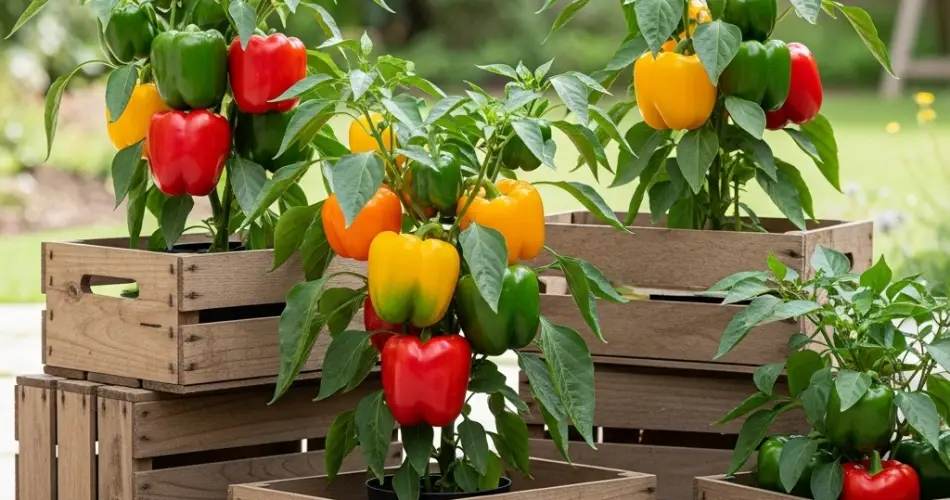Peppers are a vibrant and versatile addition to any home garden, offering a wide range of flavors from sweet and mild to fiery hot. If you don’t have the luxury of a large vegetable patch, growing peppers in crates is a practical and charming solution. This rustic method not only saves space but also adds a decorative touch to your outdoor area.
Whether you’re aiming to produce crisp bell peppers for salads, sweet banana peppers for pickling, or hot chilies for cooking, crate gardening makes the process simple, manageable, and rewarding.
Why Grow Peppers in Crates?
Planting peppers in crates provides several key benefits:
-
Space Efficiency – Ideal for balconies, patios, or small yards.
-
Better Soil Control – You can tailor the soil mix to suit peppers perfectly.
-
Portability – Move crates to chase the sun or protect from bad weather.
-
Aesthetic Appeal – Wooden crates have a rustic charm that enhances garden design.
-
Pest Reduction – Elevating peppers can make them less vulnerable to ground-dwelling pests.
Choosing the Right Crate
Select sturdy, untreated wooden crates that can hold soil without warping. The crate should be at least 12 inches deep to allow for healthy root development. To keep soil in place while ensuring good drainage, line the inside with burlap or landscape fabric. Make sure there are small gaps or holes for excess water to escape.
Selecting Pepper Varieties
Different peppers thrive in containers, so your choice will depend on flavor preferences and intended use.
Sweet Varieties:
-
Bell peppers (‘California Wonder,’ ‘Golden Bell’)
-
Sweet banana peppers
Mild to Medium Heat:
-
Poblano
-
Shishito
Hot Varieties:
-
Jalapeño
-
Cayenne
-
Habanero
Shorter, compact pepper plants are often best for crate growing, but with good care, even larger types can succeed.
Materials You’ll Need
-
Wooden crate (12–16 inches deep)
-
Quality potting mix enriched with compost
-
Pepper seedlings or seeds
-
Mulch (straw, shredded leaves, or coco husk)
-
A sunny spot (6–8 hours of direct sunlight daily)
Planting Peppers in Crates
-
Prepare the Crate
Place the crate in a sunny location. Fill it with high-quality potting soil mixed with compost for nutrients and good drainage. -
Planting from Seedlings
Transplant seedlings into the crate, spacing them 12–16 inches apart. If you’re planting more than one variety, ensure they have enough space to prevent crowding. -
Planting from Seeds
If starting from seeds, sow them about ¼ inch deep and keep the soil consistently moist until germination. This process usually takes 7–14 days, depending on the variety.
Caring for Crate-Grown Peppers
Peppers thrive with steady care.
-
Watering – Keep the soil evenly moist but never waterlogged. Crates drain well, so in hot weather you may need to water daily.
-
Fertilizing – Every 2–3 weeks, feed with a balanced vegetable fertilizer or compost tea to encourage strong, healthy plants and good fruit production.
-
Support – Some pepper plants may need stakes or small cages to prevent branches from bending under the weight of the fruit.
Mulching for Moisture and Health
A layer of mulch helps retain soil moisture, reduces weeds, and keeps soil temperatures stable. Straw, shredded leaves, or coco husks all work well for crate-grown peppers.
Managing Pests and Diseases
Peppers grown in crates are less prone to some soil-borne diseases, but you should still watch for common issues:
-
Aphids – Rinse with a strong spray of water or use insecticidal soap.
-
Spider Mites – Mist plants regularly to increase humidity, as mites thrive in dry conditions.
-
Blossom End Rot – Prevent by keeping soil moisture consistent and ensuring adequate calcium levels.
Harvesting Peppers
You can pick peppers at any stage of maturity, depending on flavor preference. Green peppers are usually sweeter and crunchier when fully mature, while hot peppers intensify in heat as they ripen and change color.
To harvest, use scissors or pruning shears to cut peppers from the stem. Pulling by hand can damage the plant.
Extending the Growing Season
If cooler temperatures arrive early in your area, simply move the crate to a warmer spot or into a greenhouse to extend the harvest. Peppers are warm-season plants and will keep producing as long as they have enough sunlight and warmth.
Final Thoughts
Growing peppers in crates combines functionality, style, and convenience. With the right crate, soil mix, and care routine, you can enjoy a steady supply of fresh peppers from your own backyard, patio, or balcony. This rustic approach turns even the smallest outdoor space into a productive pepper patch, bringing you one step closer from crate to plate.



